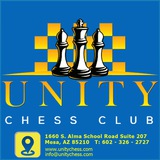31.e6+ Ke7 32.d6+ Kxd6 33.e7 Rfe8 34.Nxa8 Rxe7 35.Rxe7 Kxe7 36.Rb1! b4 37.Kg2 Kd6 38.Kf3 Kc6 39.Ke2 1-0
18...exf5 19.e6 Rg8 20.exf7+ Kxf7 21.Bg2, with a strong attack.
18...Qc7 19.fxe6 Bxe6 (19...fxe6 20.Nf6+ Kd8 21.Nxd5 exd5 22.Qxd5+ Ke8 23.Bc4 Rf8 24.Rhf1+–) 20.Ng7+ Kd7 21.Nxe6 fxe6 22.Qxg4 Qc6 23.Bh3, with the initiative.
18...Qc7 19.fxe6 Bxe6 (19...fxe6 20.Nf6+ Kd8 21.Nxd5 exd5 22.Qxd5+ Ke8 23.Bc4 Rf8 24.Rhf1+–) 20.Ng7+ Kd7 21.Nxe6 fxe6 22.Qxg4 Qc6 23.Bh3, with the initiative.
Unity Chess Club
Vasily Smyslov Arnold Denker Moscow 1946 White to move
The d6-pawn is Black’s main problem. But to press on it conveniently, White needs to secure some space on the light squares, and this task is achieved by...
With the exchange of light-squared bishops, Black loses his last hopes of counterplay. White can put his rooks on d3 and d1, and Black can no longer hassle them with a bishop from f5 or g4. In another situation, Black could try to activate his position a little with ...b6-b5, but in this position, such a break is impossible.
25...Kh7 26.Bxe6 Qxe6 27.Rd3 Rc7 28.Rcd1 Rf7 29.Ne4 Bf8 30.Rd5 Qg4 31.R1d3
White gradually seizes space for his pieces – the rook on d5 assists the advance of the a-pawn, if White wishes.
This wins at once, so White is able to dispense with further manoeuvring and strengthening of his position. But now imagine that the d6-pawn was defended. In this case, White can strengthen his position with the moves Kg1-g2 and a2- a4. Later, depending on circumstances, he can play a4-a5, or advance the h-pawn with h2-h4, further restricting the black bishop, and creating the potential threat of h4-h5.
